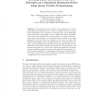23 search results - page 4 / 5 » Evolving Individual Behavior in a Multi-agent Traffic Simula... |
AICOM
2002
13 years 7 months ago
2002
The computational potential of artificial living systems can be studied without knowing the algorithms that govern their behavior. Modeling single organisms by means of socalled c...
JSW
2007
13 years 7 months ago
2007
Abstract—This paper describes a biologically-inspired architecture, called SymbioticSphere, which allows data centers to autonomously adapt to dynamic environmental changes. Symb...
GECCO
2003
Springer
14 years 20 days ago
2003
Springer
We describe the first instance of an approach for control programming of humanoid robots, based on evolution as the main adaptation mechanism. In an attempt to overcome some of th...
CORR
2010
Springer
13 years 7 months ago
2010
Springer
This paper presents a modeling process in order to produce a realistic simulation of crowds in the ancient Greek agora of Argos. This place was a social theater in which two kinds...
IROS
2008
IEEE
14 years 1 months ago
2008
IEEE
— A hormone-inspired task scheduling method is described which assigns tasks to a group of robots, taking into account the robots’ performances. This method draws on previous w...

